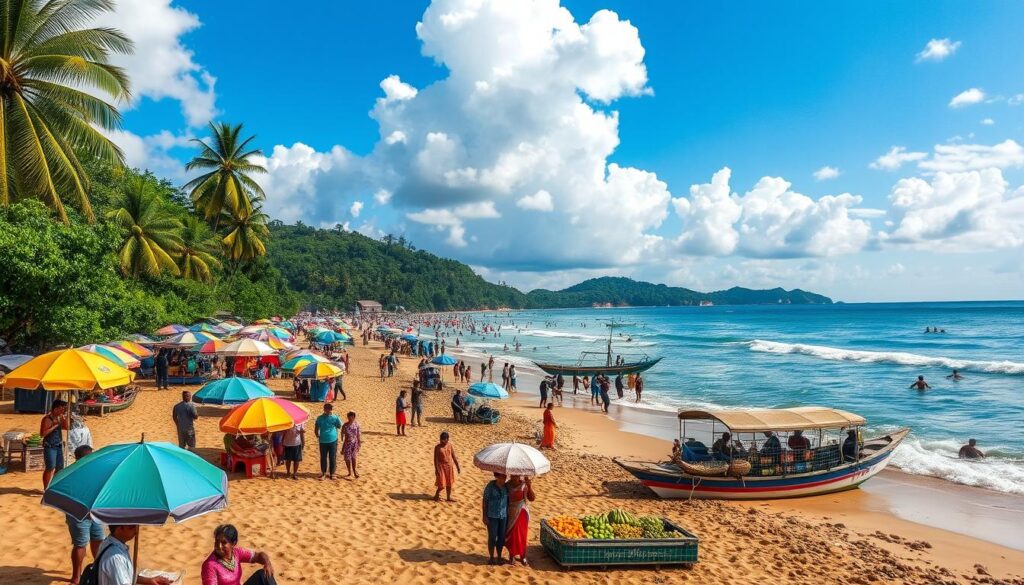Sri Lanka’s Eco-Friendly Initiatives Boost Tourism Numbers
Sri Lanka is making big moves in sustainable tourism. The government has set new rules to boost eco-tourism. Their efforts paid off with a UN award for mangrove restoration.
Tourism is vital to Sri Lanka’s economy, making up 10% of GDP. But rapid growth has caused problems. Hotels use more water and make more waste than regular homes.
To fix this, Sri Lanka created the R-NSTC framework. It covers nine areas, including sustainability and community engagement. The framework aims to make tourism more eco-friendly.
The R-NSTC launch event drew over 100 guests. It also unveiled the Uva Provincial Tourism website. This site showcases top tourist spots in the Uva province.
Eco-tourism is already working well in Sri Lanka. Wildlife parks drew 39.2% of tourists in 2023. Hurulu Eco Park was the most popular spot.
Most hotels in Sri Lanka are working towards eco-friendly practices. The THASL President highlighted this trend.
Gal Oya Lodge is a great example of sustainable tourism. It hires 80% of staff from nearby villages. The lodge also works with wildlife groups on research projects.
Another success story is the Barnhouse Studio. It’s Sri Lanka’s first upcycled hotel. The hotel won an award for its eco-friendly practices in 2023.
Sri Lanka’s eco-tourism matches global trends. The country has room to grow in this area. By focusing on sustainability, Sri Lanka can attract more eco-minded travelers.
The government and private sector are working together. Their efforts should boost tourism and help the economy. At the same time, they’re protecting Sri Lanka’s natural beauty.
Key Takeaways
- Sri Lanka is actively promoting sustainable tourism through eco-friendly initiatives and legal amendments.
- The R-NSTC framework and Uva Provincial Tourism Promotional website aim to uplift the eco-tourism industry.
- Wildlife parks and eco-lodges are attracting a significant portion of tourist arrivals.
- Hotels and resorts in Sri Lanka are embracing sustainability and local community engagement.
- Sri Lanka’s ecotourism practices align with global trends and have the potential for further growth.
Sri Lanka’s Commitment to Sustainable Tourism
Sri Lanka is making big moves to boost eco-tourism. The government has set new rules to help the industry grow. These steps aim to protect the country’s natural beauty.
A key project is restoring mangrove ecosystems. In two years, 326 hectares of mangroves were planted. This effort helps save wildlife and fight climate change.
Sri Lanka’s work on mangroves has won praise. The UN gave them a Flagship Award for their efforts.
Government Regulations and Legal Amendments
The Sri Lanka Tourism Development Authority (SLTDA) is working with the UN. They’ve created a plan to make tourism more eco-friendly. This plan focuses on hotels first.
The SLTDA is helping with money and know-how. They’re running a test project for eco-friendly tourism certificates.
Tourism Minister John Amaratunga says sustainable growth is key. The goal is to make Sri Lanka a top eco-friendly spot in 3-5 years.
International Recognition for Mangrove Restoration Efforts
Sri Lanka’s work to restore ecosystems has caught global attention. Their mangrove planting efforts stand out. Here’s a look at what they’ve achieved:
| Year | Mangrove Area Planted (Hectares) | International Recognition |
|---|---|---|
| 2019 | 150 | – |
| 2020 | 176 | United Nations Flagship Award |
| Total | 326 | – |
These efforts help preserve Sri Lanka’s unique nature. They also make the country more appealing to eco-conscious tourists. Sri Lanka is setting a great example for other countries to follow.
Eco-Tourism Attractions and Infrastructure Development
Sri Lanka is boosting sustainable tourism through eco-friendly attractions and improved infrastructure. The country has unveiled new national parks and wildlife sanctuaries. These include the 2,500-hectare Gal Oya National Park and Manigala Forest Lodge.
The government has upgraded sanitary facilities at popular eco-tourism spots. These improvements cater to foreign tourists at Sinharaja, Kanneliya, Hurulu, Knuckles, and Udawattakele. They ensure a comfortable and hygienic environment for visitors.
Online Ticket Reservation System for Popular Destinations
Sri Lanka has launched “Day Visitor E-Permits” for several national parks. This online system covers Yala, Udawalawe, Horton Plains, Kaudulla, Minneriya, and Wilpattu. Visitors can now plan trips easily and avoid long queues.
These eco-tourism efforts have boosted Sri Lanka’s tourism industry. In early 2023, the country welcomed over 524,000 tourists. May 2023 saw an 8% increase in foreign arrivals compared to last year.
| Year | Foreign Tourist Arrivals | Eco-Tourism Engagement |
|---|---|---|
| 2018 | 2.3 million | 52% (1.1 million) |
| 2000 | 400,414 | 1% (4,004) |
Sri Lanka faces challenges from climate change and unsustainable practices. Yet, it remains dedicated to sustainable tourism and biodiversity conservation. With its unique species and protected areas, Sri Lanka could become a top eco-tourism destination.
Sri Lanka’s Eco-Friendly Initiatives Attract Surge in Tourism
Sri Lanka’s eco-friendly tourism practices have boosted visitor numbers. The country’s tourism sector has seen a rise in eco-conscious travelers. In early 2024, forest attractions drew 364,521 tourists, up from previous years.
Significant Increase in Local and Foreign Tourist Arrivals
Sri Lanka’s focus on ecotourism has improved its appeal. The country upgraded roads, airports, and tech to enhance visitor experiences. These changes attracted both foreign and local tourists.
Sri Lanka aims for 2.3 million foreign tourists this year. Their goal for 2025 is 3 million visitors.
Rising Percentage of Foreign Tourists Among Visitors
The share of foreign tourists has grown steadily. In 2022, they made up 19.8% of visitors. This rose to 27.8% in 2023 and 40% in 2024.
Free 30-day visas for 35 countries started October 1. This move has attracted more international tourists. Tourism earnings reached $1.88 billion in seven months, a 73.3% increase from last year.

